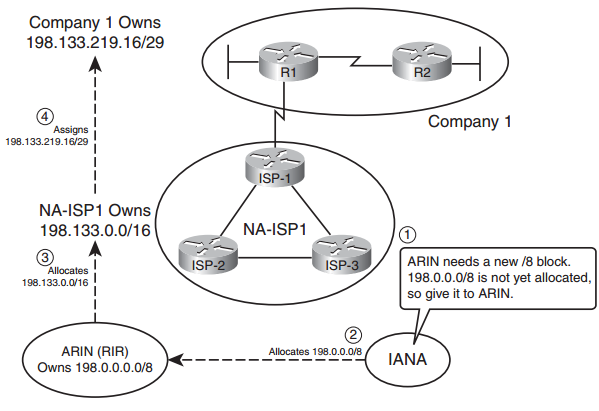CCNP Route FAQ: Internet Connectivity and BGP
Q1. Which of the following are considered private IPv4 addresses? (Choose two.)
a. 192.16.1.1
b. 172.35.1.1
c. 225.0.0.1
d. 127.0.0.1
e. 10.1.1.1

Figure: Conceptual View of Public IPv4 Address Assignment
Q2. Class C network 200.1.1.0/24 was allocated to an ISP that operated primarily in Asia. That ISP then assigned this entire Class C network to one of its Asian customers. Network 200.1.2.0/24 has yet to be assigned to any ISP. Which of the following is most likely to be true?
a. 200.1.2.0/24 could be assigned to any registrar or ISP in the world.
b. 200.1.2.0/24 will be assigned in the same geography (Asia) as 200.1.1.0/24.
c. 200.1.2.0/24 cannot be assigned as public address space.
d. Routers inside North American ISPs increase their routing table size by 1 as a result of the customer with 200.1.1.0/24 connecting to the Internet.
Q3. Router R1, in ASN 11, learns a BGP route from BGP peer R22 in ASN 22. R1 and then uses BGP to advertise the route to R2, also in ASN 11. What ASNs would you see in the BGP table on R2 for this route?
a. 22
b. 11
c. 1
d. None
Q4. Which of the following are most likely to be used as an ASN by a company that has a registered public 16-bit ASN? (Choose two.)
a. 1
b. 65,000
c. 64,000
d. 64,550
Q5. Which of the following statements is true about a router’s eBGP peers that is not also true about that same router’s iBGP peers?
a. The eBGP peer neighborship uses TCP.
b. The eBGP peer uses port 180 (default).
c. The eBGP peer uses the same ASN as the local router.
d. The eBGP peer updates its AS_Path PA before sending updates to this router.
Q6. Which of the following is the primary motivation for using BGP between an Enterprise and its ISPs?
a. To influence the choice of best path (best route) for at least some routes
b. To avoid having to configure static routes
c. To allow redistribution of BGP routes into the IGP routing protocol
d. To monitor the size of the Internet BGP table
Q7. The following terms describe various design options for Enterprise connectivity to the Internet. Which of the following imply that the Enterprise connects to two or more ISPs? (Choose two.)
a. Single Homed
b. Dual Homed
c. Single Multihomed
d. Dual Multihomed